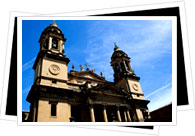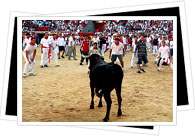Highlights:
A prime spot to start off your walking tour of La Navarrería is the tree-lined Plaza del Castillo, affectionately known as "Pamplona's living room". Occupying some 14,000 square meters, the plaza has long been the stage for major events: battles, tournaments, markets, military parades and, until 1844, even bullfights. Today it's still the heart and soul of the city and a constant hub of activity.
Built on the site of Pamplona's former castle, it's the city's favorite spot to poke around shops, meet up with friends, people-watch, or nurse a steaming coffee in any of the fashionable cafés - including Hemingway favorite Café Iruña - that look out onto the plaza.
To the south and west of the plaza you'll find the area of the former Judería, a compact area of narrow streets where Pamplona's Jewish population lived up until the persecutions and expulsions of the Spanish Inquisition saw the Jewish population dwindle down to zero.
El Ayuntamiento Just a couple minutes' walk form Plaza del Castillo via Calle Chapitela will lead you to the emblematic Plaza Consistorial and the Ayuntamiento (City Hall). Come July 6th, thousands upon thousands of revelers pack into the square to raucously ring in the official beginning of the city's beloved celebration, Los Sanfermines, with a rocket launched from the second balcony of the Ayuntamiento. One week later the crowd convenes again to mourn the end of yet another year's festival of thrilling bull runs and round-the-clock partying.
Just a couple minutes' walk form Plaza del Castillo via Calle Chapitela will lead you to the emblematic Plaza Consistorial and the Ayuntamiento (City Hall). Come July 6th, thousands upon thousands of revelers pack into the square to raucously ring in the official beginning of the city's beloved celebration, Los Sanfermines, with a rocket launched from the second balcony of the Ayuntamiento. One week later the crowd convenes again to mourn the end of yet another year's festival of thrilling bull runs and round-the-clock partying.
Symbolically constructed just where Pamplona's three boroughs - La Navarrería, San Cernin and San Nicolás - converge, the Ayuntamiento has been the seat of the municipal government since the uniting of the three boroughs in 1423. The original structure was torn down years ago, replaced in the 18th century. Today, only the elaborate Baroque façade, an elaborate 4 level sculptured masterpiece incorporating columns, allegorical figures and topped with a Neoclassical clock, of that 18th century structure remains.
Portal de FranciaFrom the Plaza Consistorial, pass through the Plaza de los Burgos and up Calle Palacio, which will eventually bring you to the Portal de Francia. Looking out over the Arga River, the Portal de Francia is one of the best-preserved sections of Pamplona's remaining defensive walls. To get a feel for just how unpenetrable the former fortress-city was, take a few minutes to head through the gate and check out the walls from the outside.
Catedral de Santa María From the Portal de Francia, take Calles Carmen and Navarrería to get to the Catedral de Santa María. To the left of Calle Navarrería you'll see the former Convento de las Carmelitas Descalzas, a 17th century convent where exhibitions and other cultural activities are now held. Take a right down Calle Dormitaleria, one of the oldest and most peaceful streets in Pamplona, and walk alongside the Cathedral until you reach the entrance.
From the Portal de Francia, take Calles Carmen and Navarrería to get to the Catedral de Santa María. To the left of Calle Navarrería you'll see the former Convento de las Carmelitas Descalzas, a 17th century convent where exhibitions and other cultural activities are now held. Take a right down Calle Dormitaleria, one of the oldest and most peaceful streets in Pamplona, and walk alongside the Cathedral until you reach the entrance.
Don't be turned off by the unimpressive Neoclassical façade that was added in the 18th century, because the Catedral's interior blows its exterior away. Built over 130 years starting in 1397, the Catedral de Santa María is a stunning example of Gothic architecture, featuring stained glass windows, sculpted doorways, pointed arches and a sober atmosphere. The Catedral stands on the site of a former Romanesque basilicia and its layout features three naves and the form of a Latin cross.
In the center nave you can check out the sculpted tombs of Carlos III, the king who united the city, along with his wife Leonor, and around the perimeter of the cathedral you can take a peak at the various smaller chapels tucked between the buttresses. Pay special attention to the octagonal Gothic vault of the Barbazán chapel, the oldest chapel in the Catedral and home to Bishop Armando Barbazán's (1319-1355) tomb. Ironically, it's also one of the most popular chapels in the Cathedral in which Pamplona locals get married!
The gem of the Catedral, however, is its magnificent cloister. The cloister was built between 1286 and 1472 and, with dozens of pointed arches, a small garden and decorative sculptures adorning the keystones, is considered one of Europe's very best Gothic cloisters.
Parque de la TejeríaBehind the Catedral is one of the city's many parks, the Parque de la Tejería. Its peaceful paths wind through fountains, fish pools, trees and monuments. Follow the park as it wraps around the old city walls until you reach one of the city's many old, surviving bridges: the medieval Puente de Magdalena.
Bullring Back at the cathedral, continue down Calle Dormitalería and you'll reach the corner of Pamplona's famous bullring, the second largest in Spain after Madrid's Las Ventas. Holding nearly 20,000 spectators, the bullring is the final destination on the Running of the Bulls route. Outside the main entrance, take a stroll down the Paseo de Hemingway, an avenue dedicated to Ernest Hemingway that even features a monument dedicated to the American writer and bullfighting aficionado.
Back at the cathedral, continue down Calle Dormitalería and you'll reach the corner of Pamplona's famous bullring, the second largest in Spain after Madrid's Las Ventas. Holding nearly 20,000 spectators, the bullring is the final destination on the Running of the Bulls route. Outside the main entrance, take a stroll down the Paseo de Hemingway, an avenue dedicated to Ernest Hemingway that even features a monument dedicated to the American writer and bullfighting aficionado.